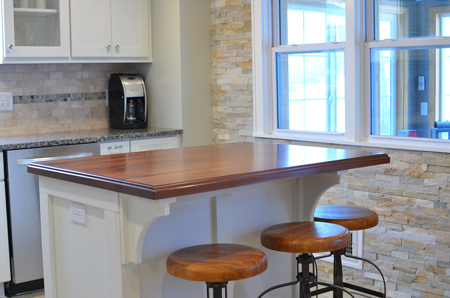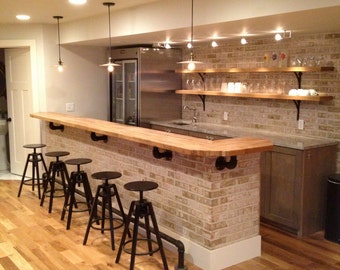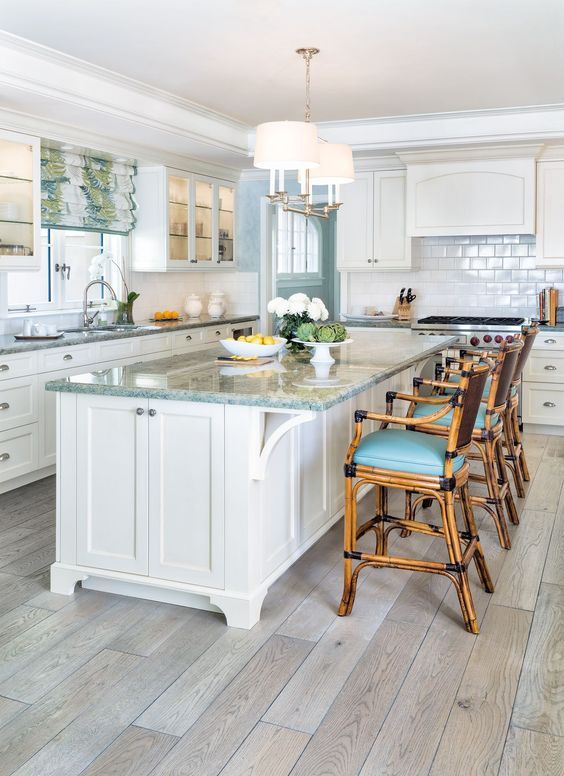Wood plank kitchen countertops offer a warm and inviting aesthetic to any kitchen space, bringing a touch of natural beauty indoors. Here’s a comprehensive overview of this popular countertop option:
Material Options: Wood plank countertops are typically crafted from a variety of wood species, including maple, oak, cherry, walnut, and teak. Each wood type offers unique grain patterns, colors, and characteristics, allowing homeowners to choose a material that complements their kitchen décor and personal style.
Customization: One of the major advantages of wood plank countertops is the ability to customize them according to specific preferences. Homeowners can select the type of wood, thickness of the planks, and finish to create a customized look that suits their needs.
Warmth and Texture: Wood plank countertops add warmth and texture to the kitchen, creating a cozy and inviting atmosphere. The natural variations in grain and color contribute to a rustic or organic aesthetic that enhances the overall design of the space.
Versatility: Wood plank countertops are versatile and can be incorporated into various kitchen styles, from traditional to modern. They complement a wide range of cabinetry finishes and hardware options, making them a versatile choice for any kitchen design.

Durability: When properly maintained, wood plank countertops are durable and long-lasting. Hardwood species such as maple and oak are particularly resilient and can withstand the demands of daily use in the kitchen.
Sealing and Maintenance: To protect against moisture damage and stains, wood plank countertops require regular sealing and maintenance. Applying a food-safe sealant helps to seal the wood and prevent water penetration, while routine maintenance such as wiping up spills promptly and avoiding harsh cleaning chemicals extends the lifespan of the countertops.
Surface Protection: Using cutting boards and trivets is essential to prevent scratches, dents, and heat damage to wood plank countertops. These protective measures help preserve the integrity of the wood surface and maintain its appearance over time.
Refinishing: Over time, wood plank countertops may show signs of wear and tear, such as scratches or discoloration. Fortunately, they can be refinished to restore their original beauty. Sanding out imperfections and applying a fresh coat of sealant rejuvenates the countertops and extends their lifespan.

Cost: The cost of wood plank countertops varies depending on factors such as the type of wood, size of the countertop, and complexity of the installation. While hardwood species tend to be more expensive than other countertop materials, their timeless appeal and durability make them a worthwhile investment for many homeowners.
Sustainability: Opting for sustainably sourced wood ensures that your countertops are environmentally friendly. Look for certifications such as Forest Stewardship Council (FSC) certification, which indicates that the wood was harvested from responsibly managed forests.
Design Flexibility: Wood plank countertops offer design flexibility, allowing homeowners to incorporate unique features such as live edges or custom inlays. These personalized touches add character and individuality to the kitchen space.
Compatibility with Undermount Sinks: Wood plank countertops can accommodate undermount sinks, providing a seamless and visually appealing transition between the countertop and sink. Proper sealing and waterproofing around the sink cutout are essential to prevent water damage to the wood.

Maintenance Tips: To maintain the beauty and longevity of wood plank countertops, it’s essential to follow proper maintenance practices. Regularly clean the surface with a mild soap and water solution, and periodically reapply sealant to protect against moisture and stains.
Resilience to Wear and Tear: Despite being a natural material, wood plank countertops are surprisingly resilient to wear and tear. With proper care and maintenance, they can withstand the rigors of everyday use in the kitchen and maintain their beauty for years to come.
Investment Value: Wood plank countertops are not only a beautiful addition to the kitchen but also an investment in the value of the home. Their timeless appeal and durability make them an attractive feature for potential buyers, enhancing the overall appeal of the kitchen space.

Are wood plank countertops suitable for use in high-traffic kitchens?
Yes, wood plank countertops can withstand the demands of high-traffic kitchens when properly maintained. Hardwood species such as maple and oak are particularly durable and resilient, making them suitable for use in busy kitchen environments.
Can I cut directly on wood plank countertops?
It is not recommended to cut directly on wood plank countertops, as this can cause scratches and damage to the surface. Using cutting boards helps protect the wood and preserves its appearance over time.
How often should I reseal wood plank countertops?
The frequency of resealing wood plank countertops depends on factors such as the type of wood and level of use. As a general guideline, it’s recommended to reapply sealant every 1 to 2 years or as needed to maintain optimal protection against moisture and stains.

Sapele Mahogany Countertops – J. Aaron

wow. just beautiful. wood plank countertops — LOVE! wood countertops Pinterest Wide plank

Walnut Plank Countertops traditional-kitchen

Wood Countertop for Tierrasanta Kitchen Remodel San Diego Custom Building & Remodeling – J

Walnut Wide Plank Countertops – Country Mouldings

Custom Reclaimed Wood Plank Countertops for 45 dollars a sq ft

Hardwood Flooring Ideas With Pros And Cons – DigsDigs

Quartz Countertops Colors in 2020 Replacing kitchen countertops, Quartz countertops, Kitchen

Regal Havana Hickory Color Cohiba Flooring, Floor installation, Vinyl plank flooring

Related Posts:
- Affordable Kitchen Countertop Ideas
- Kitchen Design White Countertops
- Engineered Stone Kitchen Countertops
- Gray Tile Kitchen Countertop
- Green Kitchen Countertop Options
- Kitchen Countertop Decorating Ideas
- Solid Wood Kitchen Countertops
- Average Cost Of Quartz Kitchen Countertops
- Contemporary Kitchen Countertops
- Cheap Kitchen Island Countertops